Water-repellent ef ficiency of thermally modi fied wood as affected by its permeability
Asghar Tarmian•Akbar Mastouri
Introduction
Thermal modi fication is well known as a commercial environmentally friendly method to reduce the hygroscopicity of wood.However,the major disadvantages of thermally modi fied wood are reduction in the mechanical strengths,susceptibility to termite attacks,and weathering discoloration(Anonymous 2003).More information about the properties of the modi fied wood can be found in Esteves and Pereira(2009).Thermal modi fication reduces the free hydroxyl groups(OH)of wood,which is mainly due to degradation of hemicelluloses.Consequently,the reduced hygroscopicity of thermally modi fied wood is often related to its lower accessible OH groups(Ja¨msa¨and Viitaniemi 2001;Boonstra and Tjeerdsma 2006).Reduction in the water–vapor absorption of wood as a result of thermal modi fication was reported in almost all previous studies(Esteves and Pereira 2009).
The liquid water uptake by thermally modi fied wood may be important for certain applications.It is accepted that wood porosity and its permeability are the main factors that control its liquid water uptake.In comparison to sapwood,the lower liquid water uptake of softwood heartwood is often attributed to pit aspiration and encrucstation of the tracheid pit membranes with extractives(Johansson et al.2006).Thermal modi fication alters the porous structure of Scots pine sapwood by damaging the membranes of the fenestriform cross field pits,which lead to an increase in the longitudinal water absorption(Johansson et al.2006).
In contrast to the hygroscopic properties,contradictory results were reported on the effect of heat treatment on the liquid water uptake by wood(Table 1).Reduction in the liquid water uptake of wood due to heat treatment was found in the most studies.Metsa-Kortelainen et al.(2006)found that in contrast to the heartwood of Scots pine,heat treatment increases the liquid water uptake by the sapwood.The author also reported that the water uptake of Norway spruce decreases by increasing the treatment temperature.It has been stated that heat treatment of black pine(Pinus nigraArnold)at 180 and 210°C by ThermoWood process reduces its liquid water uptake after a short soaking time but the ef ficiency reduces at the prolonged exposure(Wang and Cooper 2005).
In several studies,considerable changes were observed in the anatomical structure of wood due to heat treatment,such as rupture in the ray parenchyma cell,pit torus,and membrane;development of checks in the secondary wall and middle lamella;hydrolyzation of bordered pits;increase in the size and proportion of pores;and collapse of vessels(Fengel 1989;Gosselink et al.2004;Andersson et al.2005;Boonstra et al.2006;Dashti et al.2012).Thus,it is expected that the mass transfer properties can also be modi fied in heat-treated wood.Permeability of wood significantly depends on its porous structure.Contradictory changes in the wood permeability caused by heat treatment indicate its dependence on the porous structure of wood and the heat treatment conditions(see Table 2).
The modi fication of pore structure and permeability caused by thermal modi fication may be important in the capillary water uptake of the modi fied wood.The present study gives some information about changes in the transverse air permeability of different hardwood species due to thermal modi fication and its contribution to their water uptake.
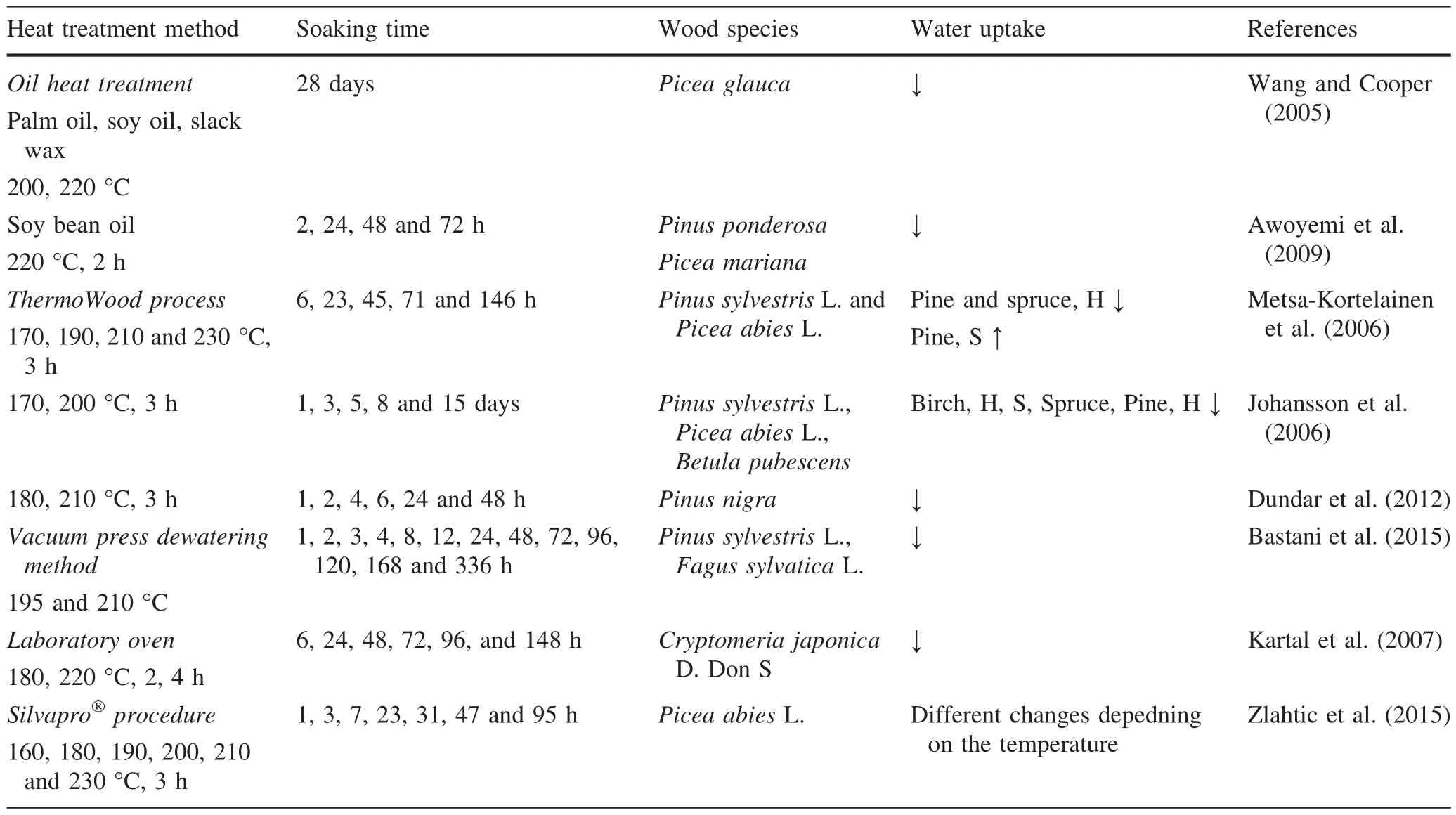
Table 1 Change in the water uptake of wood due to heat treatment
Materials and methods
Board preparation,drying method and thermal modi fication
Freshly cut boards of hornbeam(Carpinus betulus),poplar(Populus nigra),and oak heartwood(Quercus castanifolia),all with nominal thickness of 20 mm were selected for the study.Thermal modi fication was performed inside a ThermoWood kiln using a process similar to the Thermo-S process,introduced by VTT Technical Research Centre of Finland(Anonymous 2003).Green lumber can also be used;they are first dried in a ThermoWood kiln using a high-temperature drying process.
The kiln temperature was first rapidly raised to about 100°C and and then gradually increased to 140 °C.After drying,the temperature was increased to 180°C,and thermal modi fication was carried out at the target temperature for 3 h.Cooling and moisture conditioning were finally applied for 24 h to lower the wood temperature and bring its moisture content to about 7%.This strategy at the finalstage prevents surface and internalchecking.Anatomical changes of the wood specimens caused by thermal modi fication were studied using environmentalscanning electron microscopy(ESEM).
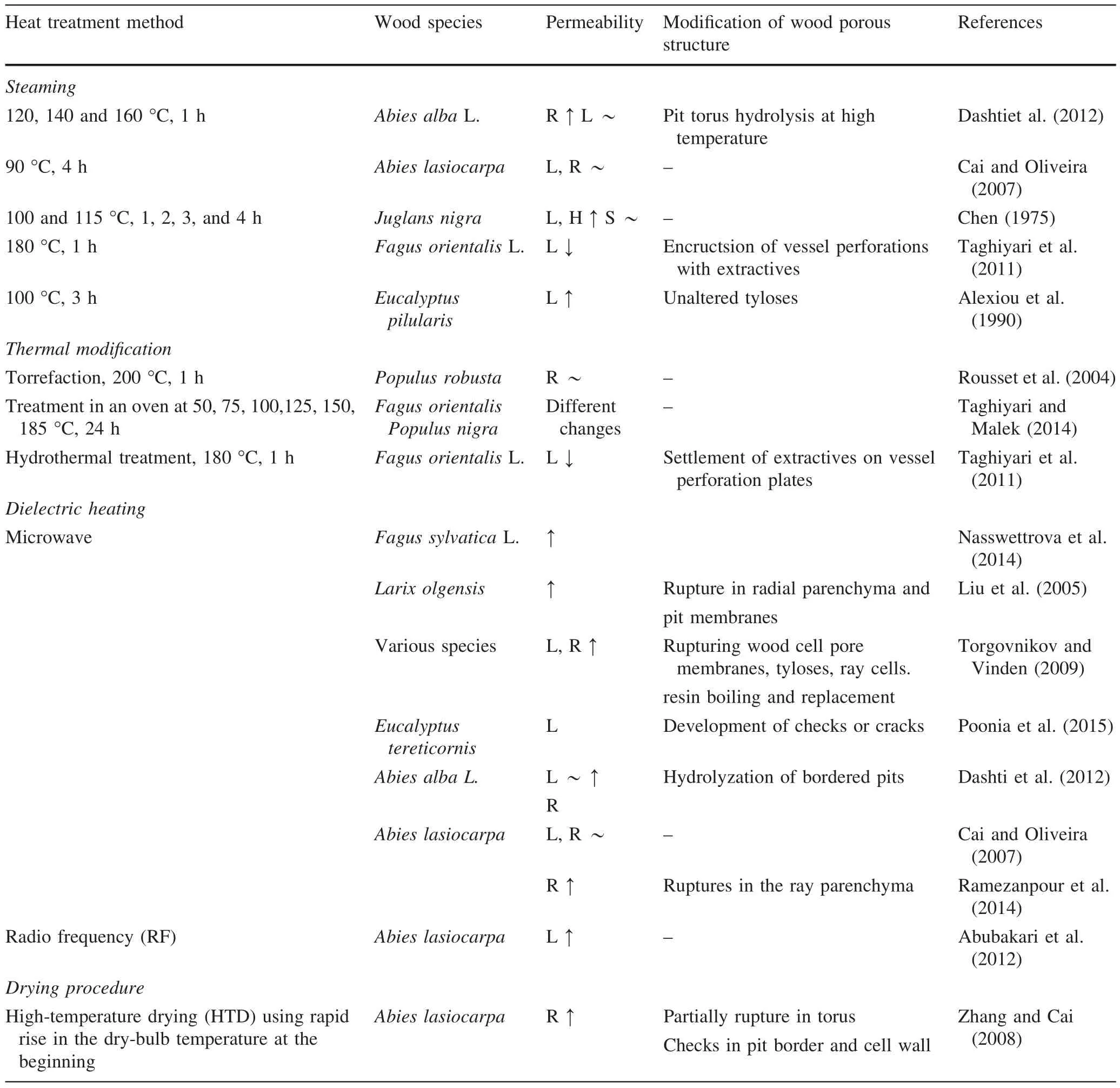
Table 2 Change of wood permeability due to heat treatment
Measuring air permeability
Cylinders that were 20 mm in diameter with 10 mm in length were prepared in the tangential direction of the wood.Two layers of epoxy resin were first applied on the lateral surfaces of specimens to avoid laterally fluid flow.They were then conditioned inside a climatic room(20°C and 65%RH).A falling water displacement method depicted in Fig.1 was used to measure the air permeability(Rayirath and Avramidis 2008;Siau 1995).The time needed to lower the level of water by Δzwas recorded to calculate the super ficial permeability(kg)in m2s-1Pa-1:

whereVd= πr2Δz(m3),Patmis air pressure(Pa),Δzis change in water level(m),¯zis the average height of water in the storage space(m),Lis the sample length(m),tis the time(s),Ais the area at the cross section of sample(m2),tis the time(s),andCis the correction factor for gas expansion during measurement:

whereVr=volume of device above point 1(m3).The speci fic permeability(K)(m3m-1)was calculated using Eq.3

where μ is the air viscosity(μ =1.81 × 10-5Pa s).Ten repetitions were used for each treatment.
Measuring water-repellent ef ficiency
Water uptake of the oven-dried specimens—20 mm in the radial(R)and tangential(T)directions and the 10 mm in longitudinal(L)directions—was measured after soaking in distillated water at ambient temperature for 24 h.Then the water-repellent ef ficiency(WRE)was calculated by Eq.4

where Wuand Wmare the water uptake of untreated and modi fied wood,respectively.Anti-volumetric swelling ef ficiency(ASE)for 24 h of immersion time was also calculated by Eq.5

where Suis volumetric swelling of control sample,and Smis that of modi fied wood.The maximum water uptake test was also conducted;for this test,the oven-dried specimens were put in flasks and the initial vacuum of 0 mbar was applied for 30 min.Thereafter,distillated water was injected into the flasks by syringe and the specimens were leftsubmerged in room-temperature conditions for 25 days.Five samples were prepared for each treatment.

Fig.1 The device used for measuring the air permeability(Siau 1995)
Statistical analysis
SPSS software was used to statistically analyze the experimental data.For multiple comparison of means,the Duncan multiple range test(DMRT)was used at the signi ficance level of 0.05.
Results and discussion
Anatomical structure
ESEM observations showed that the fiber cells of modi fied hornbeam were significantly collapsed while the vessel and parenchyma cells remained unaltered(Fig.2).The collapse may be the result of huge stresses developed in the wood structure as a result of thermal modi fication during free water removal.It is thought that the capillary forces developed during bulk flow of free water can be high enough in some wood species to cause the cell wall collapse.We did not observe the collapse in poplar and oak(Fig.3).In contrast,Boonstra et al.(2006)and Sayar and Tarmian(2013)reported that poplar is susceptible to collapse of vessels during heat treatment,indicating that the heat treatment conditions are the important parameters causing the cell wall collapse.Therefore,the cell collapse is affected by the wood species and characteristics of the process.In agreement with some previous reports(Torgovnikov and Vinden 2009;Poonia etal.2015;Ramezanpour et al.2014;Zhang and Cai 2008),several checks developed in the cell walls and between the adjacent cells of wood specimens as a result of thermal modi fication.Some visible checks can be seen in poplar wood(Fig.3b).Change in the porosity of heat-treated wood is thought to be due to the cell-wall rupture and formation of various sized cavities(Andersson et al.2005;Taghiyari 2013).Overall,it can be concluded that the modi fication of the pore structure caused by heat treatment may be minor for some wood species.
Air permeability
The air permeability of poplar and hornbeam was strongly affected by thermal modi fication(Fig.4).A clear increase occurred in the permeability of hornbeam,whereas the permeability of poplar was significantly reduced after the modi fication.However,there was no signi ficant change in the permeability of oak after thermal modi fication,indicating that the modi fication may have different impacts on the permeability of wood,which may be explained by ESEM observations.
Increase in the permeability of hornbeam is probably due to collapsing fibers,leading to microcracks in the cell walls.Increase in the longitudinal permeability ofEucalyptus pilularis(Alexiou et al.1990),longitudinal and radial permeability ofAbies albaL.(Dashti et al.2012),reduction in the permeability ofPopulus nigra(Sayar and Tarmian 2013)and no changes in the permeability ofPopulus robusta(Rousset et al.2004)and Subalpine fir(Abies lasiocarpa)(Poonia et al.2015)due to heat treatment were also reported.
These contradictory reports probably resulted from different heat-treatment methods and degree of thermal modi fication.It was stated that the modi fication of wood permeability by heat treatment is temperature dependent(Hietala et al.2002;Bao et al.1999).In contrast to thermal modi fication process,Rhatigan et al.(2003)found that the drying temperature had no signi ficant effect on the gas permeability of western hemlock lumber.
Increase in the wood permeability resulted from heat treatment is often explained by the occurrence of rupture in radial parenchyma,cell walls,pit torus,and membranes(Dashti et al.2012;Liu et al.2005;Zhang and Cai 2008;Torgovnikov and Vinden 2009;Ramezanpour et al.2014;Poonia et al.2015).For example,rupture in the radial parenchyma cells caused by high-intensity microwave treatment can be effective to increase the fluid permeability along the radial direction(Liu et al.2005;Torgovnikov and Vinden 2009;Ramezanpour et al.2014).Reinprecht et al.(2010)found that microwave treatment is more effective to improve the treatability of green sapwood of Norway spruce,which explains that the improving effect of the treatment is more remarkable when the bordered pits of tracheids are yet opened.
However,checking in the wood structure is not to be always desirable for improving its permeability depending on the wood species and anatomical direction.Despite check formation in modi fied poplar wood(Fig.3b),the thermal modi fication had a negative effect on its permeability,which reveals that other unknown changes may contribute to the property.Bordered pits extremely affect wood permeability.Extractives may obstruct the pit membranes which could slow fluid flow through the wood structure.Thermal modi fication may alter the extractives deposited on the cell walls and pits(Esteves and Pereira 2009).
Mass losses with thermal modi fication ranged from 9 to 22%depending on the wood species(Table 3).The highest mass loss was observed in hornbeam.The mass loss is explained by thermal degradation of the cell wall polymers of wood.The degree of mass loss is affected by wood species and heat treatment conditions(Esteves and Pereira 2009).The higher temperature and longer treatment time cause greater mass loss.

Fig.2 ESEM images of thermally-modi fied(a)and untreated(b)hornbeam wood
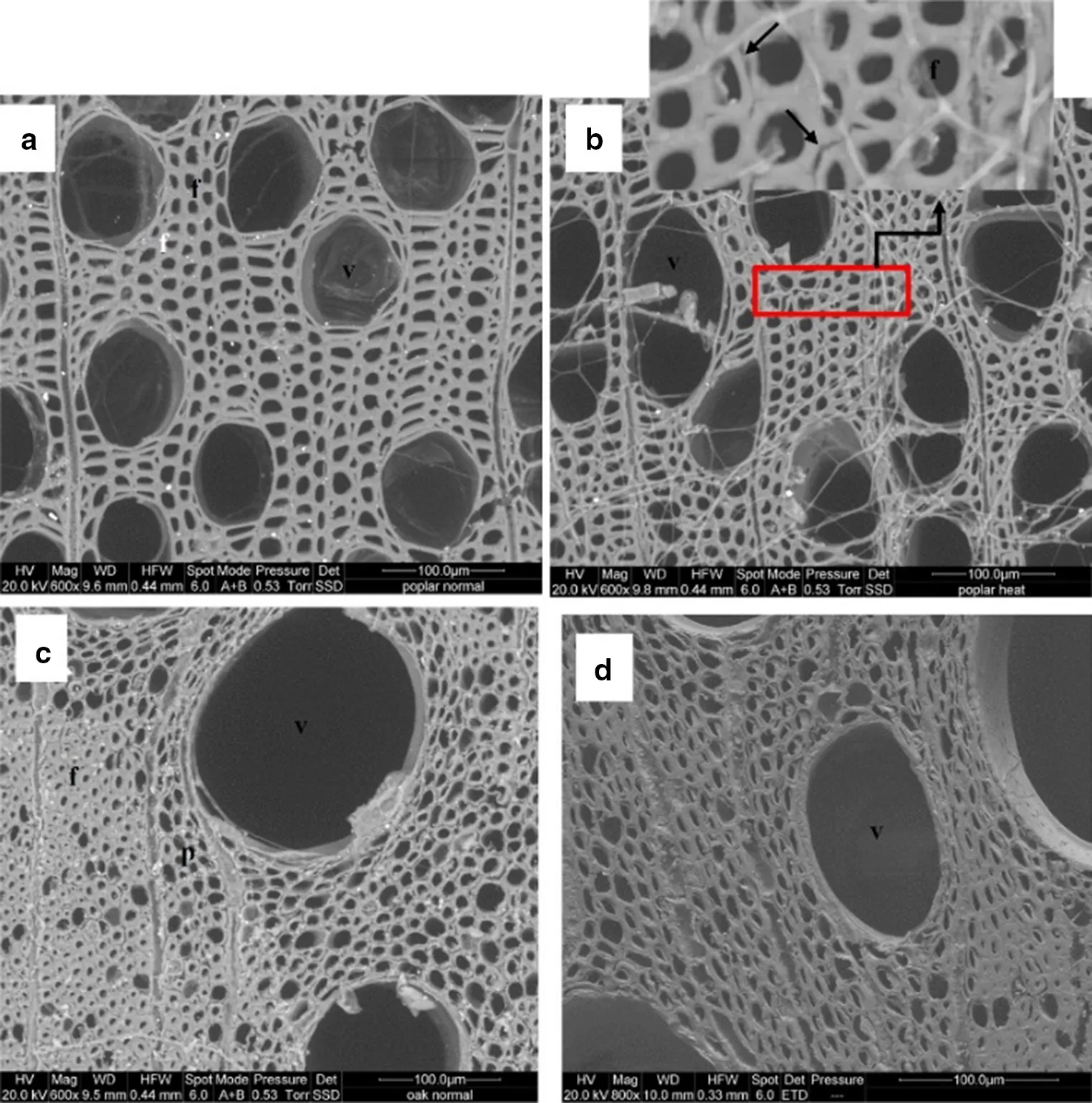
Fig.3 ESEM images of untreated and thermally-modi fied wood:a untreated poplar,b modi fied poplar,c untreated oak and d modi fied oak.v vessel,p parenchyma cell,f fiber
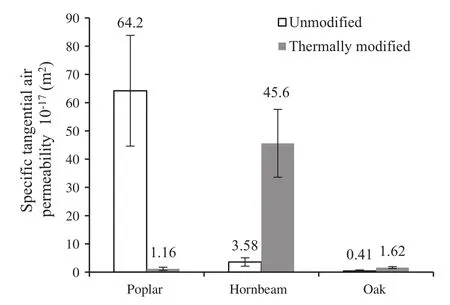
Fig.4 Speci fic tangential air permeability of control and thermally modi fied wood of poplar,hornbeam and oak
We found no correlation between the wood density and permeability whether in control and thermally modi fied wood(Fig.5).In other words,higher mass loss of thermally modi fied wood may not be accompanied by higher permeability.Previous researches also have shown that the wood density has no effect on the permeability(Rayirath and Avramidis 2008;Bao et al.1999).
Water-repellent ef ficiency(WRE)
In contrast to oak and poplar with positive WRE values of 18.7 and 14.2%,the water uptake of hornbeam was enhanced rather than reduced by heat treatment(WRE=-7.7%),probably due to the increased permeability(Table 3).Previous studies also showed that heat treatment may have a negative effect on the water-repellent ef ficiency depending on the wood species(see Table 1).Johansson et al.(2006)indirectly showed that permeability is a determining factor in the water uptake of pine wood.The authors reported that high extractive content and aspirated bordered pits are the main factors that reduce the water uptake of pine heartwood.It is well known that the above factors reduce the permeability of wood.The movement rate of water through wood directly depends upon its porosity and permeability.
Cracks increase in the proportion of intercellular spaces of wood caused by heat treatment,which may increase the capillary water flow along the longitudinal direction(Zauer et al.2014).Our results proved that the role of permeability is very important in controlling the water-repellent ef ficiency of thermally modi fied wood:namely,increasing it induces a noticeable reduction in the ef ficiency.It is believed that the reducing effect of heat treatment on the liquid water uptake is more pronounced after shortly soaking of wood in water(Wang and Cooper 2005).
In contrast to oak and poplar,the water-repellent ef ficiency of hornbeam reduced even more when the experimental maximum-water uptake was measured(WRE24h=-7.7%;WREmax=-13.6%).It should be noted that the theoretical maximum water uptake could be higher depending on the porosity of individual wood species.A good linear correlation was observed between the density and maximum water uptake,whether in control and thermally modi fied woods(Fig.6)which indicates that the porosity of heat-treated wood also determines its maximum water uptake.Thermal modi fication was effective to decrease the swelling of all three wood species.
The high dimensional stability of thermally modi fied wood is mainly due to degradation of hemicelluloses at high temperatures,which causes reduction in its af finity to moisture.The anti-swelling ef ficiency is often improved by using higher temperatures and longer treatment times.The ef ficiency also varies in relation to the species and the wood direction(Esteves and Pereira 2009).The swelling of wood can be reduced by 50–90%after thermal modi fication using the ThermoWood process(Guller 2012).Our results showed that the volumetric ASE was 32.6%for poplar,56.9%for oak,and 45.4%for hornbeam after immersion in water for 24 h.Moreover,the ASE of poplar reached 58.7%following the soaking time of 25 days.Guller(2012)also reported that ASE of thermally modi fiedpine(Pinus nigra)improves by increasing the immersion time.

Table 3 Mass loss,water-repellent and anti-volumetric swelling ef ficiency for thermally modi fied wood of oak,poplar and hornbeam
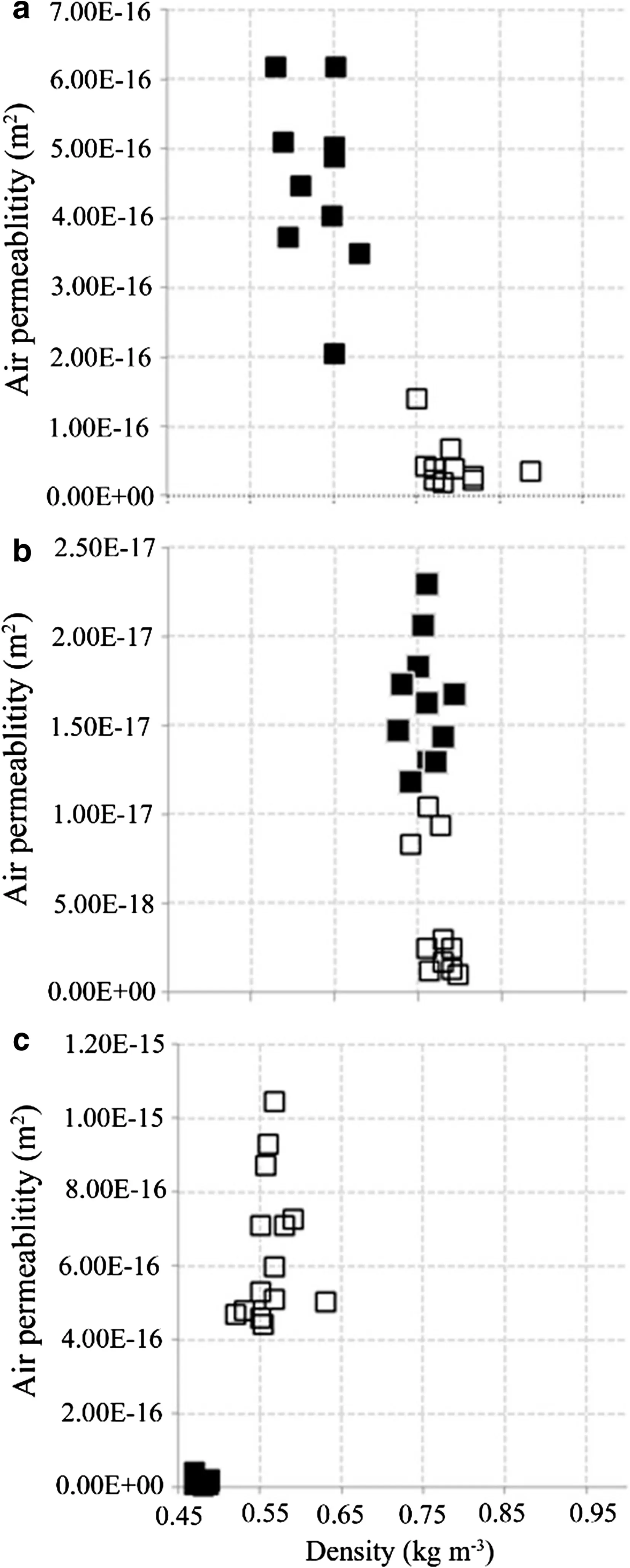
Fig.5 Air permeability versus density for unmodi fied(open square)and thermally modi fied wood( filled square).a Hornbeam;b oak;c poplar
However,we found no remarkable change in the ASE of hornbeam and oak by increasing the soaking time.Therefore,the anti-swelling ef ficiency of the modi fied wood can be clearly seen even after soaking in water for a short time but the ef ficiency may be improved after prolonged exposure to water,depending on the wood species and degree of thermal degradation.
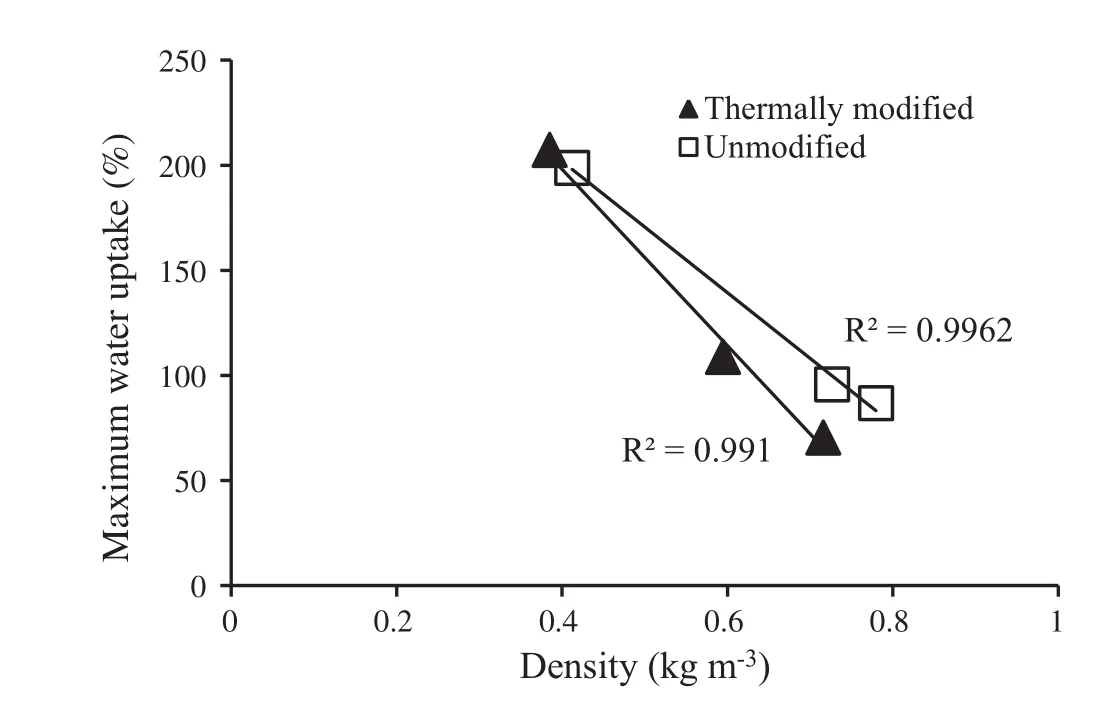
Fig.6 Experimental maximum water uptake versus density for unmodi fied and thermally modi fied wood
Conclusions
In this work,we found that thermal modi fication may have different impacts on the wood permeability and its porous structure depending on the wood species.Micro-cracking in the cell walls of hornbeam,due to collapsing of fiber cells,caused a clear increase in its permeability.However,this study suggests that crack formation in the wood structure due to heat treatment may not always be effective to improve its permeability,and it is affected by wood species and the fluid flow direction in wood.
We found that the capillary water flow through thermally modi fied wood is controlled by the combined effects of porosity and permeability.Increase in the wood permeability due to thermal modi fication results in a negative water-repellent ef ficiency,and the ef ficiency is reduced even more following prolonged exposure to water.We also found that the anti-swelling ef ficiency of the modi fied wood may be more effective when the soaking time is increased and the corollary is also true:following shorttime exposure to liquid water,the ef ficiency may be underestimated,depending on the wood species.
AcknowledgementsThe authors are grateful to Prof.Ingo Burgert,Prof.Emil Engelund Thybring,Ms.Vivian Merk and Ms.Ste´phane Croptier in the Wood Materials Science Group at the Institute for Building Materials at ETH Zurich.
References
Abubakari A,Avramidis S,Oliveira LC(2012)Impact of radio frequency heating pre-treatment on the kiln drying characteristics of sub-alpine fir.Eur J Wood Wood Prod 70(1):245–251
Alexiou PM,Wilkins AP,Hartley J(1990)Effect of presteaming on drying rate,wood anatomy and shrinkage of regrowthEucalyptus pilularisSm.Wood Sci Technol 24(1):103–110
Andersson S,Serimaa R,Va¨a¨na¨nen T,Paakkari T,Ja¨msa¨ S,Viitaniemi P (2005)X-ray scattering studies of thermally modi fied Scots pine (PinussylvestrisL.).Holzforschung 59(4):422–427
Anonymous(2003)ThermoWood handbook:Finnish ThermoWood Association
Awoyemi L,Cooper PA,Ung TY(2009)In-treatment cooling during thermal modi fication of wood in soy oil medium:soy oil uptake,wettability,water uptake and swelling properties.Eur J Wood Wood Prod 67(4):465–470
Bao FC,Lu JX,Avramidis S(1999)On the permeability of main wood species in China.Holzforschung 53:350–354
Bastani A,Adamopoulos S,Militz H(2015)Water uptake and wetting behaviour of furfurylated,N-methylol melamine modi fied and heat-treated wood.EurJWood Wood Prod 73(5):627–634
Boonstra MJ,Tjeerdsma B(2006)Chemical analysis of heat treated softwoods.Holz als Roh-und Werkstoff 64:204–211
Boonstra MJ,Rijsdijk JF,Sander C,Kegel E,Tjeerdsma B,Militz H,Acker J,Stevens M(2006)Microstructral and physical aspects of heat treated wood.Part 2.Hardwoods.Maderas Ciencia y tecnologı´a 8(3):209–218
Cai LP,Oliveira LC(2007)Gas permeability of wet wood and normal wood of sub-alpine fir in relation to drying.Dry Technol 25:501–505
Chen PYS(1975)The effect of steaming time and temperature on the longitudinal permeability of black walnut.Wood Fiber Sci 7(3):222–225
Dashti H,Tarmian A,Faezipour M,Hejazi S,Shahverdi M(2012)Effect of pre-steaming on mass transfer properties ofPicea abiesL.;a gymnosperm species with torus margo pit membrane.BioResources 7:1907–1918
Dundar T,Buyuksari U,Avci E,Akkilic¸H(2012)Effect of heat treatment on the physical and mechanical properties of compression and opposite wood of black pine.BioResources 7(4):5009–5018
Esteves BM,Pereira HM (2009)Wood modi fication by heat treatment:a review.BioResources 4(1):370–404
Fengel D,Wegener G(1989)Wood:chemistry,ultrastructure,reactions.Walter de Gruyter,Berlin
Gosselink RJA,Krosse AMA,Putten JC,Kolk JC,Klerk-Engels B,Dam JEG (2004)Woodpreservationoflow-temperature carbonization.Ind Crop Prod 19:3–12
Guller B(2012)Effects of heat treatment on density,dimensional stability and color ofPinus nigrawood.Afr J Biotechnol 11(9):2204–2209
Hietala S,Maunu SL,Sundholm F,Ja¨msa¨S,Viitaniemi P(2002)Structure of thermally modi fied wood studied by liquid state NMR measurements.Holzforschung 56:522–528
Ja¨msa¨S,Viitaniemi P(2001)Heat treatment of wood,better durability without chemicals.In:Proceedings of special seminar held in antibes,France,February 9,pp 47–51
Johansson D,Sehlstedt-Persson M,Moren T(2006)Effect of heat treatment on capillary water absorption of heat-treated pine,spruce and birch.Wood Struct Prop 6:251–255
Kartal SN,Hwang WJ,Imamura Y(2007)Water absorption of borontreated and heat-modi fied wood.J Wood Sci 53(5):454–457
Liu HH,Wang QW,Yang L,Jiang T,Cai YC(2005)Modi fication of larch wood by intensive microwave irradiation.For Res 16(3):237–240
Metsa-Kortelainen S,Antikainen T,Viitaniemi P(2006)The water absorption of sapwood and heartwood of Scots pine and Norway spruce heat-treated at 170 °C,190 °C,210 °C and 230 °C.Holz als Roh-und Werkstoff 64:192–197
Nasswettrova A,Smira P,Jirˇı´Z,Sebera V(2014)Axial permeability of beech wood treated by microwave heating for distilled water.Wood Res 59(1):25–37
Poonia PK,Tripathi S,Sihag K,Kumar S(2015)Effect of microwave treatment on air permeability and preservative impregnation ofEucalyptus tereticorniswood.J Indian Acad Wood Sci 12(2):89–93
Ramezanpour M,Tarmian A,Taghiyari HR(2014)Improving impregnation properties of fir wood to acid copper chromate(ACC)with microwave pre-treatment.iForest 8:89–94
Rayirath P,Avramidis S(2008)Some aspects of western hemlock air permeability.Maderas Ciencia y tecnologı´a 10(3):185–193
Reinprecht L,Resˇetka M,Makovı´ny I(2010)Impregnability of spruce wood after its treatment with microwaves.Acta Fac Xylologiae Zvolen 52(2):43–51
Rhatigan RG,Milota MR,Morrell JJ,Lavery MR(2003)Effect of high temperature drying on permeability and treatment of western hemlock lumber.For Prod J 53(9):55–58
Rousset P,Perre P,Girad P(2004)Modi fication of mass transfer properties in poplar wood(P.robusta)by a heat treatment at high temperature.Holz Roh Werkst 62:113–119
Sayar M,Tarmian A(2013)Modi fication of water vapor diffusion in poplar wood(Populus nigraL.)by steaming at high temperatures.Turk J Biol 37:511–515
Siau JF(1995)Transport processes in wood.Springer,New York
Taghiyari HR(2013)Effects of heat-treatment on permeability of untreated and nanosilver-impregnated native hardwoods.Maderas Ciencia y tecnologı´a 15(2):183–194
Taghiyari HR,Malek BM(2014)Effect of heat treatment on longitudinal gas and liquid permeability of circular and square-shaped native hardwood specimens.Heat Mass Transf 50(8):1125–1136
Taghiyari HR,Talaei A,Karimi A(2011)A correlation between the gas and liquid permeabilities of beech wood heat-treated in hot water and steam mediums.Maderas Ciencia y tecnologı´a 13(3):329–336
Torgovnikov G,Vinden P(2009)High intensity microwave wood modi fication for increasing permeability.For Prod J 59(4):84–92
Wang JY,Cooper PA(2005)Effect of oil type,temperature and time on moisture properties of hot oil-treated wood.Holz als Roh-und Werkstoff 63:417–422
Zauer M,Hempel S,Pfriem A,Mechtcherine V,Wagenfu¨hr A(2014)Investigations of the pore-size distribution of wood in the dry and wet state by means of mercury intrusion porosimetry.Wood Sci Technol 48(6):1229–1240
Zhang YL,Cai LP(2008)Impact of heating speed on permeability of sub-alpine fir.Wood Sci Technol 42(3):241–250
Zlahtic N,Thaler N,Humar M(2015)Water uptake of thermally modi fied Norway spruce.Drv Ind 66(4):273–279
 Journal of Forestry Research2018年3期
Journal of Forestry Research2018年3期
- Journal of Forestry Research的其它文章
- Vacuum press drying studies on two fast-growing Indian wood species
- The nutritional composition and digestion of plants foraged by red deer(Cervus elaphus xanthopygus)in northeast China
- Predicting intensity of white-tailed deer herbivory in the Central Appalachian Mountains
- A taxonomic review of the genus Miaenia Pascoe,1864(Coleoptera:Cerambycidae)from South Korea with a new record of M.tonsa(Bates)
- A study on JA-and BTH-induced resistance of Rosa rugosa‘Plena’to powdery mildew(Sphaerotheca pannosa)
- Using UAVs for detection of trees from digital surface models
